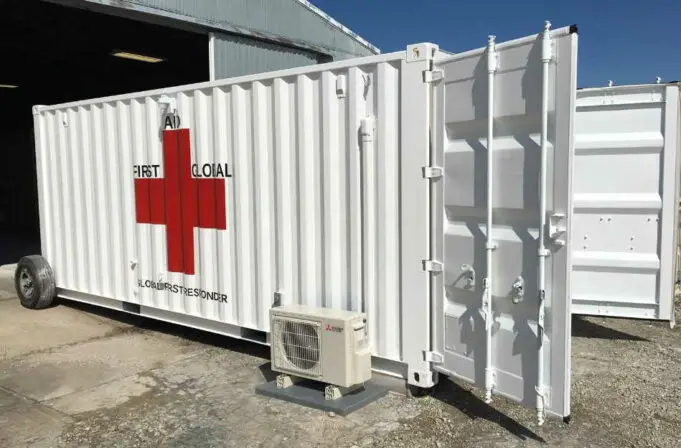Shipping containers have become a ubiquitous part of modern logistics, transforming the way goods are transported and stored. Beyond their traditional uses, these robust structures have found new applications in housing, offices and even healthcare facilities. While their versatility offers numerous benefits, it’s essential to understand the health risks and benefits associated with using shipping containers. This comprehensive guide will explore both aspects, providing a balanced view of this innovative resource.
The Health Benefits of Using Shipping Containers
Shipping containers have been repurposed into mobile clinics, vaccination centers and emergency response units. Their portability and durability make them ideal for healthcare applications, particularly in remote or disaster-stricken areas. These container-based facilities can be rapidly deployed, providing critical health services where traditional infrastructure is lacking.
Promoting Healthy Living Spaces
In urban areas with high housing demands, shipping containers offer an affordable and efficient solution for creating living spaces. When designed with proper insulation, ventilation and sanitation, container homes can provide safe and healthy living environments. These homes can also be customized to include features such as water purification systems, solar panels and energy-efficient appliances, promoting a sustainable and healthy lifestyle.
Supporting Mental Health Through Community Projects
The adaptability of shipping containers allows for the creation of community centers, recreational facilities and art spaces. These projects can foster social interaction, creativity and a sense of community, all of which are beneficial for mental health. By providing safe and engaging spaces, container-based community projects can help reduce stress, loneliness and other mental health issues.
Discover Top-Quality Shipping Containers for Sale in Dallas, Texas!
Looking for durable and versatile shipping containers in Dallas, Texas? We’ve got you covered! Our premium selection of new and used shipping containers is perfect for all your storage, transportation, and custom project needs.
Enhancing Occupational Health and Safety
In industries where temporary or mobile workspaces are needed, shipping containers can be converted into safe and secure offices or break rooms. These spaces can be equipped with proper lighting, ventilation and ergonomic furniture, ensuring a healthy work environment. Additionally, using containers for storage can protect workers from exposure to hazardous materials by providing secure and organized storage solutions.
Health Risks Associated with Using Shipping ContainersChemical Contaminants
One of the primary health risks of using shipping containers is exposure to chemical contaminants. Containers are often treated with pesticides to prevent pest infestations during transport. Additionally, the paints and coatings used on containers may contain harmful chemicals such as lead or volatile organic compounds (VOCs). Prolonged exposure to these substances can lead to respiratory issues, skin irritation and other health problems.
Structural and Environmental Hazards
Shipping containers are designed to withstand harsh marine environments, but they can pose structural and environmental hazards when used for other purposes. Rust and corrosion can compromise the structural integrity of a container, leading to potential accidents or collapses. Moreover, improper insulation and ventilation can create issues such as mold growth, poor air quality and extreme temperature variations, all of which can negatively impact health.
Ergonomic and Spatial Concerns
While shipping containers offer a compact and efficient use of space, they can also present ergonomic and spatial challenges. The confined space may limit movement and contribute to musculoskeletal problems if not properly designed. For example, insufficient headroom, narrow walkways and inadequate lighting can create a physically stressful environment, leading to discomfort and potential injuries.
Inadequate Sanitation and Hygiene
Without proper modifications, shipping containers may lack adequate sanitation and hygiene facilities. This can lead to issues such as improper waste disposal, limited access to clean water and insufficient bathroom facilities. These conditions can increase the risk of infections, illnesses and overall poor health, particularly in settings where containers are used for housing or healthcare purposes.
Mitigating Health Risks: Best PracticesConducting Thorough Inspections and Remediation
Before repurposing a shipping container, it’s crucial to conduct a thorough inspection for any signs of chemical contamination, rust, or structural damage. Professional remediation may be necessary to remove harmful substances and ensure the container is safe for use. This process can include sandblasting, repainting with non-toxic paints and applying protective coatings to prevent future corrosion.
Ensuring Proper Insulation and Ventilation
To create a healthy indoor environment, proper insulation and ventilation are essential. Insulation helps regulate temperature and prevent condensation, reducing the risk of mold growth. Ventilation ensures a continuous supply of fresh air, improving indoor air quality and reducing the concentration of harmful pollutants. Installing windows, vents and air conditioning units can help achieve these goals.
Designing for Ergonomics and Accessibility
When converting a shipping container into a living or working space, ergonomic design should be a priority. This includes ensuring sufficient headroom, ample lighting and accessible layouts. Using modular furniture and adjustable fixtures can help maximize the limited space and create a comfortable environment. Additionally, providing clear walkways and installing ramps or lifts can enhance accessibility for individuals with disabilities.
Implementing Sanitation and Hygiene Solutions
For containers used as housing or healthcare facilities, proper sanitation and hygiene solutions are crucial. This can include installing plumbing systems, water filtration units, and sanitary waste disposal methods. Incorporating bathroom and kitchen facilities with easy-to-clean surfaces and antimicrobial materials can further enhance hygiene and prevent the spread of infections.
Adhering to Building Codes and Standards
To ensure safety and health, it’s important to adhere to local building codes and standards when repurposing shipping containers. These regulations provide guidelines for structural integrity, fire safety, electrical wiring, and other critical aspects. Consulting with architects, engineers and local authorities can help ensure compliance and mitigate potential health risks.
The Future of Shipping Containers in Health and Wellness
The innovative use of shipping containers in health and wellness is expected to grow as technology and design continue to evolve. Advances in materials science, sustainable design and smart technology can further enhance the health benefits of container-based solutions. For example, integrating smart sensors and IoT devices can monitor air quality, temperature and other environmental factors, ensuring a healthy living or working space.
Sustainable and Eco-Friendly Solutions
The sustainability of shipping containers is one of their most significant advantages. Repurposing these structures reduces waste and the demand for new construction materials. By incorporating renewable energy sources, such as solar panels and wind turbines, and using eco-friendly materials, container projects can promote environmental health and sustainability.
Expanding Access to Healthcare
As the global population grows and urbanizes, the demand for flexible and accessible healthcare solutions will increase. Shipping containers can play a vital role in meeting this demand by providing mobile and modular healthcare facilities. These units can be deployed quickly and efficiently, offering essential services such as vaccinations, diagnostics and emergency care in underserved areas.
Community and Social Impact
Shipping container projects have the potential to make a significant impact on communities by providing affordable housing, recreational spaces and essential services. These initiatives can promote social cohesion, improve quality of life and address pressing health and social issues. By fostering collaboration between designers, healthcare professionals and community leaders, container projects can create healthier and more resilient communities.
Conclusion
The use of shipping containers presents both health risks and benefits, making it essential to approach their repurposing with careful planning and consideration. By understanding and mitigating the potential health risks, we can harness the versatility and sustainability of shipping containers to create safe, healthy and innovative solutions for a variety of needs. Whether for housing, healthcare, or community projects, shipping containers have the potential to transform our built environment and promote overall health and well-being.













